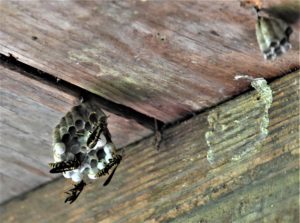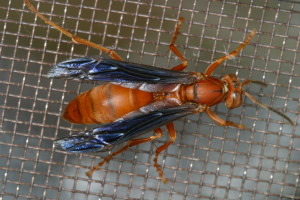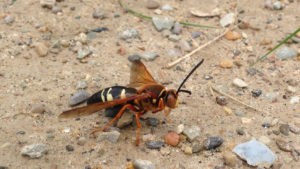The post shared below is Fascinating facts about wasps, hornets: How to get along with these beneficial bugs. The article appeared first on Insects in the City. Written by Adam Russell, Texas A&M AgriLife. Thanks to Janet Hurley for posting it and sharing it via email.
Blayne
----------------------------------

Paper wasps tending
to their nest inside a barn. Note the abandoned paper nest and remnant outline
of a mud dauber structure nearby. (Texas A&M AgriLife photo by Adam
Russell)
Murder hornets may make the headlines
because of their frightening name, but they are not in Texas. So, let’s talk
about wasps and hornets and precautions you can take to avoid stings.
All wasps and hornets are beneficial,
said Wizzie Brown, Texas A&M AgriLife Extension Service entomologist,
Austin. Homeowners can appreciate that they protect gardens and landscapes from
pests like caterpillars, spiders and aphids and
pollinate blooming plants, but a sudden sting can erase that goodwill quickly.
Brown said wasps and hornets are
focused on building nests and rearing young in any naturally occurring location
or man-made structure that provides protection from the elements like eaves of
buildings, bushes and trees.
Wasps and hornets are typically not
aggressive when they are out foraging around flowers or a trash can, Brown
said, so it is best to remain calm and avoid making aggressive movements toward
them. However, certain species are very protective of their nests.
“If nests are in an area that won’t be
disturbed, they typically are not going to be an issue,” she said. “They become
a problem when they are protecting their nests and babies, so a nest by the
front door or on your kids’ playset would be a concern.”
Brown said other locations like
doghouses and mailboxes are a few locations homeowners should monitor for
nests. If hornets or wasps are flying around a specific spot regularly, there
is a possibility a nest could be present or in the making.
All sorts of shapes,
sizes, nests and aggression levels
Yellow jackets are small with black
and yellow banded markings. They are often misidentified because other species,
like certain paper wasps, have similar reddish-brown bodies with yellow
stripes. A large ground-dwelling species known as cicada killer wasps also have yellow
and black banded markings but can reach up to 2 inches in length.

Paper wasps are
common during summer as they seek pollen.
The cicada killer wasps’ size has
caused it to be misidentified as
the murder hornet, or giant Asian hornet, which has not been
officially sighted outside of Washington state so far.
Wasp and hornet species display a
range of aggression when it comes to encroachment, Brown said. Yellow jackets
are very protective of their colony and may attack when their nest is
threatened, including vibrations from mowing. Mud daubers,
on the other hand, are very docile and typically only sting when handled
roughly.
Only female wasps and hornets sting,
Brown said. The stinger is a modified egg-laying structure called the
ovipositor. But males of some species like the cicada killer wasp will display
more territorial aggression to an intruder than females, despite its inability
to sting.
Brown said paper wasps are probably
the most common wasps people encounter across Texas. They build open-faced
paper nests typically in aerial locations and can be aggressive when their home
is disturbed. Nests are a single layer and hang from a single stalk.
“If you see an open-faced nest made
out of papery material on the eave of your home or along the ceiling of your
porch, there’s a good chance they are paper wasps,” she said.
The type of nest structure and its
location can be helpful hints as to what species is present.
Yellow jackets, for instance, build
paper nests made of chewed wood fiber like paper wasps but build single-entry
colonies and are most commonly found in cavities or underground spaces like
abandoned rodent burrows.

The cicada killer
wasp, Sphecius
speciosus, is another large wasp approaching the length of the
Asian giant wasp.
Mud daubers, on the other hand,
collect moist soil and build a structure that they provision with food and lay
their eggs. They can build these nests relatively anywhere protected from the
rain. Once they’ve filled the structure with eggs and food like spiders, they
seal the nest and leave.
Cicada killer wasps burrow into the
ground to nest. They are typically solitary nesters but will share a single
entry in the ground that leads to several egg-laying nurseries.
“Wasps and hornets are fascinating animals,”
Brown said. “It’s easy to take the good they do around our homes for granted
because we are afraid of being stung. But by learning what they do and how the
different species act, it removes a lot of the fear and helps you appreciate
seeing them around.”
Wasps and hornets come in a variety of
shapes and sizes. AgriLife Extension and the Texas Apiary Inspection Service have
great resources to help identify specific species by
sight and behavior. Also, a recent Bugs by the Yard podcast featuring
Brown and fellow AgriLife Extension entomologists covers wasps you might
encounter around the state.
Controlling wasps around
the house
Controlling where wasps and hornets
locate around your home is relatively straightforward – kill the wasps and
remove the nest. But the species and nest size present will dictate whether you
can do it yourself or should call professionals.
“A mud dauber nest that is an eyesore
on your home could be scraped off and washed,” she said. “The same goes for paper
wasp nests, but you will need to spray the wasps from a safe distance
beforehand. Spray them early in the morning or just before dark so you catch
most of the wasps. Clean the space thoroughly after removing the nest to remove
any pheromones that might attract other wasps to that location.”
Brown recommends using a spray
pesticide that can shoot a concentrated stream 8-10 feet when removing stinging
species like paper wasps.
Yellow jackets and hornets, especially
those in established colonies, should be handled by professionals, Brown said.
“Earlier in the season, when the nests
are smaller, removal might be something the DIY person could do, but when they
are really active, removal could turn into a dangerous situation without
protective clothing and specialized equipment.”
Brown said because yellowjackets and
hornets can be very aggressive in protecting their nests and can sting multiple
times, seeking shelter in a protected, closed area is the only way to avoid
stings. Common swarm scenarios are a homeowner mowing their lawn and
unwittingly alarming the colony through vibration or a farmer cutting hay and
running over an underground colony.
“I would just recommend anyone who is
consistently seeing any type of flying insect in a specific location that might
be cause for concern – whether it’s around kids or your pet or a place you
might disturb them – it might be worth taking a look to see what you’re dealing
with. Be cautious and calm and don’t get too close, but knowing what insect you
have could help you determine what the next step should be.”
-----------------------
Thanks,
Blayne
No comments:
Post a Comment